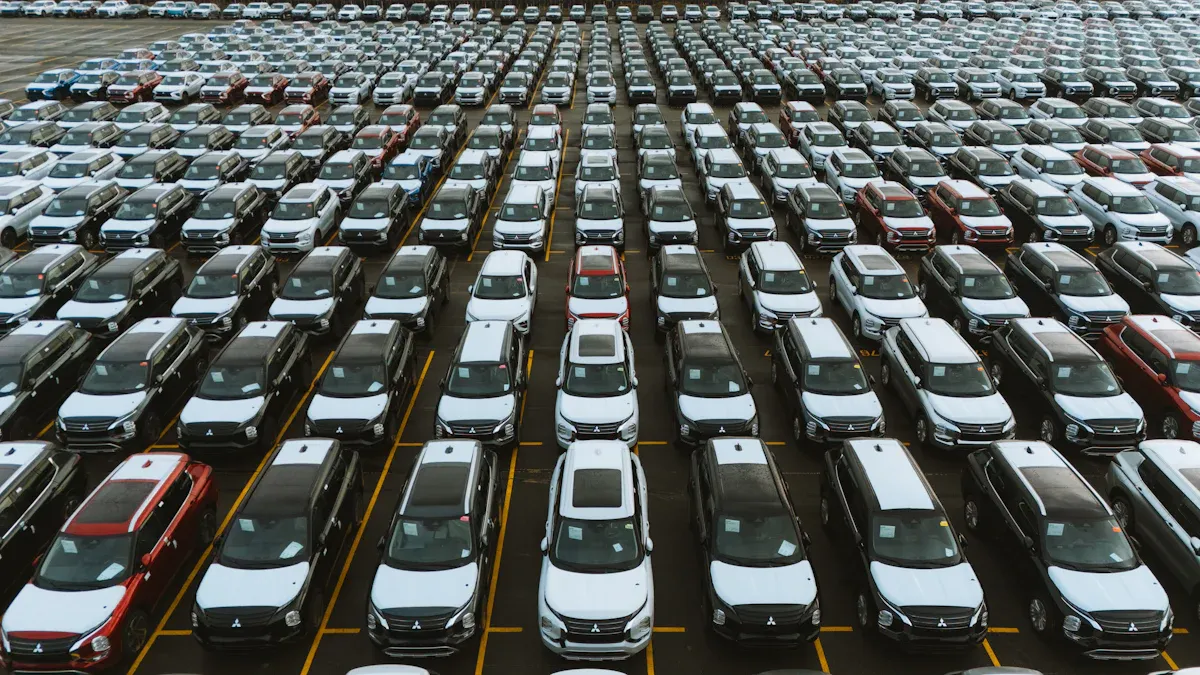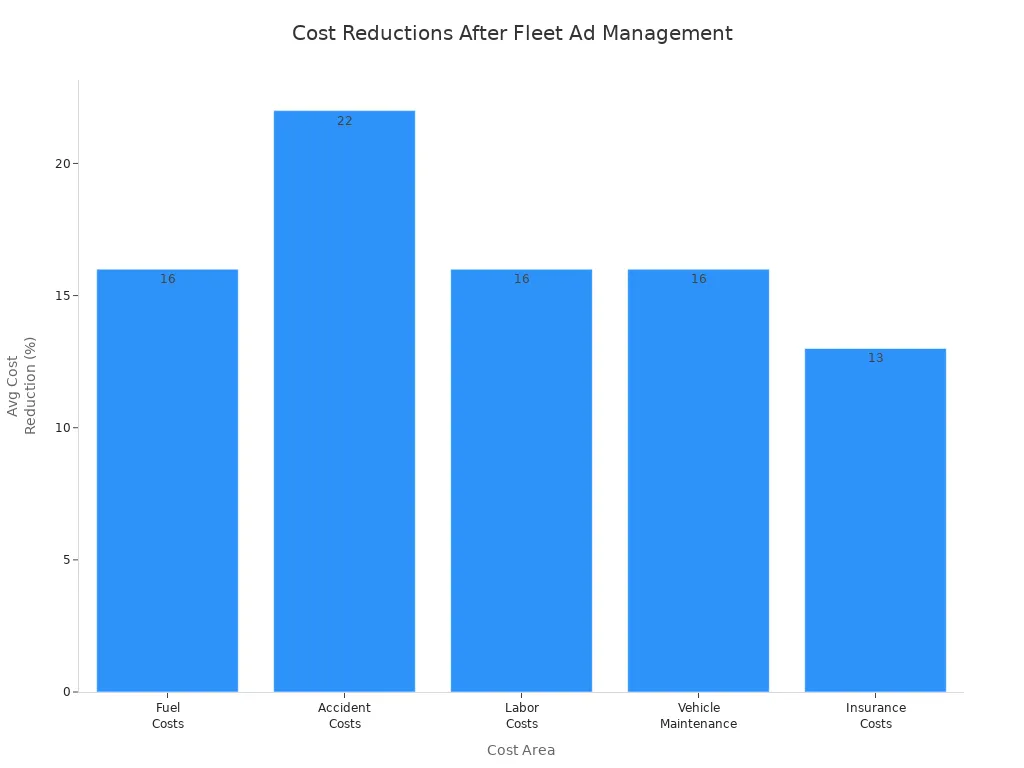
Fleet ad management systems help companies handle ads on vehicles. These systems use fleet management software and telematics to link with vehicles right away. Managers can control ads, use GPS to pick places, and check data for better results. Fleet management tools let businesses use vehicles as moving billboards. Clear goals help with using vehicle wraps and digital ads. This helps grow brand awareness and get more people interested. Telematics and GPS make tracking better, while management software makes sure each vehicle follows the plan.
Key Takeaways
Fleet ad management systems let companies watch and manage ads on their vehicles with GPS and telematics. These systems make fleets work better by giving updates right away, planning routes, and sending alerts for maintenance. Managers can use one dashboard to check ads, see where vehicles are, and watch how drivers act. These systems help save money by using less fuel, having fewer accidents, and lowering repair costs while helping more people see the ads and know the brand. All kinds of businesses can use fleet ad management systems to work safer, work smarter, and get more customers.
Fleet Ad Management Systems Overview

What They Are
Fleet ad management systems help companies watch and control ads on their vehicles. These systems use fleet management software to talk to each vehicle in the fleet. The main job is to handle ads on many vehicles at the same time. Fleet ad management systems have tools for GPS tracking, watching drivers, and keeping digital records. They also help follow rules like FMCSA standards by doing some tasks automatically. Companies use these systems to keep ads fresh and make sure every vehicle does what it should.
Tip: Fleet ad management systems can grow with your business. They work with different types of fleets and older vehicles, so companies do not have to buy new equipment.
Key parts of a fleet ad management system:
GPS tracking lets you see where vehicles are right now
Driver tracking helps make driving safer and better
Compliance management helps follow important rules
Digital documentation gives quick access and sharing
Integration and scalability help the business get bigger
Core Purpose
The main goal of fleet ad management systems is to watch over and improve ads on fleet vehicles. These systems help companies save money and work better. Fleet management software lets managers plan ads, check miles, and watch how drivers act. The system helps give better service by sending updates fast and picking the right places. Fleet vehicle management also helps companies avoid fines by keeping records and following rules automatically. Managers use data to make smart choices and keep customers happy.
Watch all fleet work to keep the business safe and making money
Save money by managing the fleet well
Give better service with quick ad changes
Make things safer with checks and watching drivers
See what the fleet is doing right now
How They Integrate with Fleet Management
Fleet ad management systems work with fleet management software and telematics using API connections. This lets data move easily between systems like accounting, dispatch, and customer tools. The connection helps with real-time GPS tracking, watching drivers, and following rules. Fleet vehicle management puts telematics, ELD, maintenance, and safety in one place. Managers can see all fleet info on one dashboard. Providers give options that can be changed and grown for any fleet size or type.
Integration Feature | Benefit |
|---|---|
API Connections | Data moves easily between systems |
Real-Time GPS Tracking | Shows where vehicles are right now |
Compliance Management | Helps follow rules automatically |
Centralized Dashboards | Makes it easy to see fleet performance |
Scalability | Lets fleets grow and use different vehicles |
Features
Centralized Control
Fleet ad management systems let managers control ads from one place. They use a dashboard to watch all vehicles and ad campaigns. This makes managing the fleet simple and helps teams learn new tools fast. The system is easy to set up and does not need much IT help. Managers can use their phones to manage vehicles anywhere. Centralized control lets the system do some jobs automatically, which saves time and work.
Note: Dashboards help managers check how fleets are doing and make quick choices.
Real-Time Updates
Real-time updates are very important in fleet ad management. Managers get instant info about where vehicles are and how ads are doing. GPS tracking and telematics give live data to help plan better routes and save gas. Smart routing and maintenance tools use sensors to stop breakdowns and cut down on waiting. Artificial intelligence looks at live data to help managers make better choices and use less energy. Fleet tracking keeps managers ready to change ad plans when needed.
Watching in real time makes fleets work up to 15% better
Fast route changes save gas and time
Fixing problems before they happen costs less
GPS and Telematics Integration
Fleet ad management systems need GPS and telematics to track vehicles well. GPS shows where each vehicle is all the time. Telematics gathers info about how drivers act, how much gas is used, and if vehicles are healthy. Managers use this data to make fleets safer and work better. Fleet vehicle management uses geofencing, maintenance plans, and fuel tracking to help. GPS and telematics work together to help with rules and reports.
Feature | Benefit |
|---|---|
GPS tracking | Shows where vehicles are now |
Telematics | Gives info on drivers and cars |
Geofencing | Sends ads to certain places |
Maintenance scheduling | Means less waiting for repairs |
Analytics and Reporting
Analytics and reporting tools help managers use data to make choices. Fleet management systems watch how well ads do, what things cost, and how ads perform. Reports show which ads work best and where vehicles go most. Managers use this info to make fleets better and get more value from ads. Automatic reports save time and let teams plan better.
Fleet reports help companies grow
Expense tools watch spending
Performance numbers show if ads work
Compliance
Compliance is very important for fleet ad management systems. In the US, the Department of Transportation and FMCSA have strict rules for fleets. Managers must keep track of checks, driver hours, and repairs. Electronic logging devices and telematics help do these jobs automatically. GPS tracking rules are different in each state, so managers must keep learning. Fleet vehicle management software helps keep records and follow the rules. Training and safety checks help fleets avoid fines and keep vehicles safe.
Tip: Automatic compliance tools help managers save time and lower risk.
How It Works

A fleet ad management system has steps from setup to review. Each step uses GPS, telematics, and tracking tools. These help companies control ads on their vehicles. This process helps managers make smart choices and get better results.
System Setup
Setting up a fleet ad management system needs good planning. Companies start by learning about their fleet and goals. They collect details about vehicles, routes, and ad plans. The setup process usually goes like this:
Discovery and Planning: Managers talk with experts to learn about the fleet. They gather info about tracking, ad types, and rules.
Solution Design: The team makes a plan for how the system will work. They design dashboards for dispatchers, drivers, and managers. The plan works for small and big fleets.
Architecture Planning & Development: Developers build the system using cloud tech. This keeps the system strong and easy to update.
Building Offline Capabilities: The system saves data when there is no internet. It updates data when the connection comes back.
Pre-installation and Installation: The company checks that all hardware and software fit the fleet. They install GPS tracking, telematics, and ad displays on vehicles.
Post-installation: Managers train drivers and staff. They watch the system to make sure it works well.
Tip: Careful setup helps fleets avoid problems and makes tracking easier.
Ad Scheduling
Ad scheduling lets managers pick when and where ads show up. The system uses GPS and telematics to match ads with the best routes and times. Managers can set up schedules for different days, times, or places. This helps reach the right people and keeps ads from getting old.
Managers use dashboards to choose which ads run on each vehicle.
The system uses GPS tracking to show where vehicles go.
Telematics helps pick the best times for ads using traffic and location data.
Real-time updates let managers change ad schedules fast if needed.
Ad scheduling helps more people see the ads and keeps the message new.
Vehicle Integration
Vehicle integration links the ad management system with each vehicle’s hardware. This step uses GPS, telematics, and tracking devices to collect data and control ads. The system checks that all devices work together without trouble.
Key needs for integration are:
Hardware testing: Developers check that GPS, telematics, and ad displays work with the software.
Compatibility: The system must work with many brands of GPS and telematics.
Data connection: Vehicles need internet or cloud access for live tracking and ad updates.
Sensor support: Vehicles use sensors like accelerometers and g-sensors to track driving.
Support and maintenance: Vendors help with hardware problems and replacement parts.
A good system lets managers track vehicles, control ads, and collect data fast.
Monitoring and Adjustments
When the system is running, managers use tracking tools to watch ads. They get live data from GPS and telematics. This helps them see where vehicles are and how ads look.
Managers use dashboards to check ad status and vehicle locations.
GPS tracking shows if vehicles follow planned routes.
Telematics reports on driver actions and vehicle health.
The system sends alerts if something goes wrong, like a broken ad display or missed route.
Managers can change ad campaigns quickly. They might switch ads, update schedules, or send vehicles to better spots. This keeps the fleet’s ads working well and up to date.
Note: Real-time monitoring helps fleets fix problems fast and improve ad results.
Performance Analysis
Performance analysis helps companies see if their fleet ads work. The system collects data on how many people see the ads, how often they interact, and what actions they take.
Common numbers include:
Impressions: Counts how many times people see the ads.
Clicks: Tracks how many people interact with digital ads.
Click-Through Rate (CTR): Shows the percent of people who click after seeing an ad.
Frequency: Measures how often the same person sees the ad.
Conversions: Counts actions like website visits or purchases after seeing the ad.
Cost Per Acquisition (CPA): Shows how much it costs to get a new customer.
Return on Ad Spend (ROAS): Measures how much money the fleet earns for every dollar spent on ads.
Metric | What It Shows |
|---|---|
Impressions | Brand awareness |
Clicks | Audience interest |
CTR | Ad effectiveness |
Frequency | Exposure balance |
Conversions | Campaign success |
CPA | Cost efficiency |
ROAS | Revenue from ads |
Managers use these numbers to pick the best ads. They can stop ads that do not work and spend more on good ones. This way, fleets get better results and earn more.
🚚 Tracking and checking ad performance helps fleets grow and reach more customers.
Benefits for Fleet Management
Efficiency
Fleet ad management systems make fleets work better. Managers always know where vehicles are. They can react fast to problems. They can change routes for better results. Automation helps with schedules and reports. It also reminds managers about maintenance. This means fewer mistakes and saves time. Route optimization uses live traffic and weather. It picks the best paths for each trip. This cuts fuel use and helps deliveries arrive on time. Predictive maintenance warns managers before breakdowns. Vehicles spend less time off the road. Centralized data helps managers make smart choices and improve fleets.
Managers save up to 20% time and use 15% less fuel with these systems.
Cost Savings
Companies save money with fleet ad management systems. Real-time tracking helps managers compare costs and find waste. Fuel tools track buying and usage. Maintenance features help with service and control costs. Leasing lowers ownership costs and helps with budgets. Administration gets easier with less paperwork. Staff have more free time. These changes lower costs in many areas.
Cost Area | Reported Average Cost Reduction |
|---|---|
Fuel Costs | |
Accident Costs | 22% |
Labor Costs | 16% |
Vehicle Maintenance | 16% |
Insurance Costs | 13% |

ROI Improvement
Fleet ad management systems help companies get better returns. Each vehicle is a moving billboard. It can reach 30,000 to 70,000 people every day. This helps more people see the brand and brings more leads than ads that do not move. The system uses AI and automation to check campaign results. It scores leads and makes ads fit each person. Multi-touch models show the whole customer journey. Managers can spend money where it works best. These tools help companies see good returns, often in the first year.
Enhanced Control
Managers get better control over the fleet. Dashboards show all tracking, ad results, and vehicle health in one place. Instant updates and alerts help managers act fast if there is a problem. Automated compliance tools help fleets follow rules and avoid fines. With better control, managers can improve fleets, keep vehicles safe, and run ad campaigns smoothly. This control helps fleets work better and be more efficient.
Who Should Use Fleet Ad Management Systems
Business Types
Many businesses that use vehicles can get help from fleet ad management systems. These systems help companies work faster and spend less money. Some businesses that find these systems useful are:
Sales teams, such as those selling medicine
Logistics companies that move things between cities or states
Rental car companies with lots of cars
Utility companies that send workers to many places
These businesses use fleet ad management systems to work better, keep people safe, and follow rules. Big and small companies can get more reliable service and have less downtime. Many North American companies already use these systems to see where vehicles are and save fuel. Special features, like checking for problems before they happen, help companies with workers who travel a lot. Automating jobs like work orders and keeping track of supplies helps managers make good choices.
Note: Companies that care about the environment can use these systems to watch emissions and help with green plans.
Use Cases
Fleet ad management systems can be used in many ways by different industries. Each way helps companies work better and get good results.
Planning routes and trips helps vehicles take quick paths and skip traffic.
Checking vehicle health, like batteries and brakes, stops breakdowns.
Watching how drivers act helps cut down on risky moves and saves fuel.
Security tools, like theft alerts and crash warnings, keep vehicles and goods safe.
Tracking and geofencing show where vehicles are all the time.
Sensors watch cargo, like keeping food cold during trips.
Passenger info systems give updates and make public transport better.
Watching idle time and driver habits helps lower pollution.
Cargo tools use cameras and telematics to protect things while moving.
Industries like logistics, building, healthcare, farming, public transport, FMCG, rental cars, and waste management use these systems. Each industry wants to work faster, be safer, and give better service. Fleet managers and workers use these tools to keep vehicles working well and make smart choices with data.
Fleet ad management systems help companies manage ads on vehicles. They also make fleet operations better. These systems use GPS, telematics, and smart software. They work in real time to help fleets run safely and quickly. Some main benefits are:
Automated alerts and early repairs keep vehicles working.
Custom reports and remote controls help managers make choices.
Better tracking and route planning save money and show more ads.
Experts say cloud-based solutions and AI tools work best. Companies using these systems often earn more money. They also make customers happier.
FAQ
What is a fleet ad management system?
A fleet ad management system helps companies manage ads on vehicles. It uses GPS, telematics, and software to watch ads and track vehicles. The system collects data to help make ads work better.
How does GPS help with fleet advertising?
GPS tells managers where each vehicle is right now. Managers use this to send ads to the best places. They can also see how many people might see the ads. GPS helps plan good routes for vehicles.
Can small businesses use fleet ad management systems?
Yes, small businesses can use these systems too. Many providers have options for any fleet size. Small companies can start simple and add more features later.
What types of ads can be managed?
Managers can control digital ads and printed wraps. Digital screens show messages that can change. Wraps have pictures that stay the same. The system lets managers update digital ads fast and see which ones do well.
Is it hard to set up a fleet ad management system?
Most systems are simple to set up. Providers help with setup and training. The software works with many vehicles and devices. Managers can use the system soon after it is ready.
See Also
Best CarPlay Devices Compatible With 2023 Ford F-150
Understanding Wireless CarPlay Adapters And Their Driving Benefits
Authentic Reviews Of Wireless Apple CarPlay In Ford F-150
Common Reasons Autolink Malfunctions In Mercedes-Benz Vehicles
How G37 Apple CarPlay Adapters Transform Your Driving Experience
